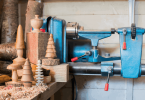Every wood working shop needs a random orbital sander. That may seem like a bold statement, but in the world of sanding machines, the random orbit type stands out as a true all-around machine. It is capable of taking down hefty amounts of stock, stripping old paint and varnishes, and, by simply changing to a finer grit, even creating silky smooth finished surfaces.
The secret ingredient of these sanders is the motion in which the sanding disc is moved. It doesn’t just go in a circle, which would leave huge swish marks all over your surface. It also moves in an elliptical pattern, usually altering a perfect circle motion by an eight of an inch. The result is movement of the sanding pad in a nearly arbitrary manner, which leaves no telltale sanding streaks on your finished surface.
It’s a critical piece of equipment in a shop, and we’re here to help you choose the best equipment for your specific needs.
Our Top 10 Picks Best Random Orbital Sander Reviewed
01 Makita BO5041K (Our Pick)
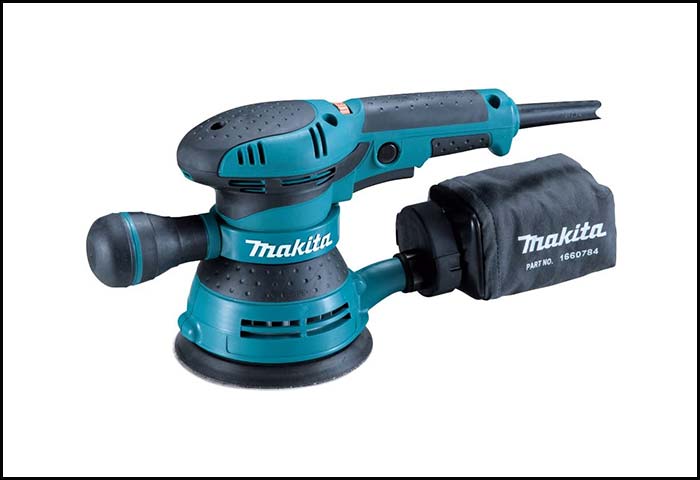
Why This Product Is Our Pick
Adaptability is the keyword in explaining why this machine gets our vote as the top-performing random orbit sander. I really like the way Makita allows the front handle to be adjusted to a variety of positions, or even to be removed completely, so the sander can squeeze into tight quarters. Combine that with the variable speed control that lets you adjust the orbits per minute anywhere from 4,000 to 12,000, and you have a sander I can fall in love with.
Detailed Review
After using the variable speed control and adjustable front handle on this machine, I am spoiled. For less than $80, you can wrap your hands around the rubberized grips, dial in the speed you want from the 3-amp motor, and get the job done with ease. This orbital sander uses a 5-inch sanding pad mounted with the fairly standard 8-hole hook-and-loop method.
The random orbit action functions in a 1/8-inch pattern to give you very smooth sanding results. It also has a pad brake so you don’t end up with those telltale swirls at the end of your sanding motions. The dust collection fan built into the machine does a very good job of catching most of the dust, and it’s made even better if you hook the machine up to your shop vac.
I do want to gripe about the dust collection bag, just a bit. It’s a typical, low-cost bag that tends to clog up a bit. Many of the machines in our list of top ten orbital sanders use a hard case dust collection system with an actual filter inside. I find that design to be more clog-free than the bag. But, then again, I usually hook the machine up to my vacuum, thus eliminating the issue.
Online reviews from actual owners praise the minimal vibrations that this orbital sander transfers to their hands. It’s comfortable, easy to use, and effective at doing its job. On the one-to-ten scale, reviewers give this machine a 9.4 rating, with more than 84% rating it a full-on 10.
Pros
- Ultra-comfortable rubberized handles
- Vibration free
- Adjustable (and even removable) front handle
- Variable speed
Cons
- Inadequate dust bag
Final Verdict
A decent price, a fantastic set of comfortable handles, and variable speed control make this a great choice for woodworking. Outside of a slightly wimpy dust bag, I simply have nothing to complain about this sander. Perhaps a more powerful motor would be nice, although I can’t say that I have ever felt it bogging down. So, maybe that just a personal preference for “more power” without any real justification. This is simply a great value for the money.
02 DeWalt DWE6421K (Runner Up)
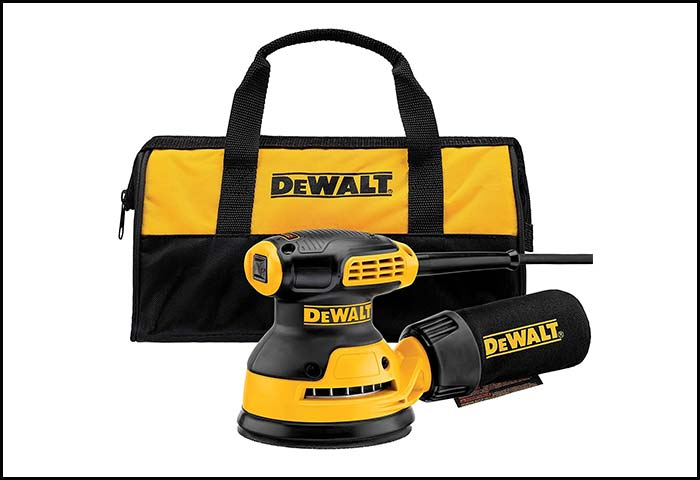
Why This Product Is Our Pick
DeWalt is a trusted name in professional grade power tools, and that reputation transfers to this little workhorse in the world of orbital sanders. I say little, because this machine is actually shorter than many of the other machines in our reviews. That may not sound like a big deal on the surface, but if that surface you want to sand is, say, the inside of a small cabinet, you will be very happy with the squatty design of this superb orbital sander.
Detailed Review
Quick question: What’s the first thing that usually fails on an orbital sander. Answer: The on/off switch because it fills up with sanding dust and the contacts fail. In addition to the low-slung design I already mentioned, the sealed power switch may be one of the top features on this superb orbital sander from DeWalt.
The rubberized handgrip area also helps reduce vibration from the unit, although I do find the lack of a second hand grip a bit disappointing. Since I’m complaining, let me also point out that this is a single-speed machine, unlike many of the units in our discussion. The 3-amp motor drives the 5-inch sanding pad at 12,000 OPM, which is a good speed for most wood working projects. Pads are mounted with the standard hook-and-loop design.
Weighing in at 4-pounds, this machine is light enough to work with all day. What I do find annoying is the fairly small dust collection bag. It goes on and off easily enough, but either it fills up too quickly, or the machine doesn’t do a good job of containing dust. I’m not sure which but I did feel it didn’t do great in collecting dust compared to other machines in our review.
Pros
- Dust-sealed power switch
- Rubber grips
- Low vibration
Cons
- Single speed
- No second handle
- Modest dust bag
Final Verdict
This high quality DeWalt random orbital sander will outlast many of your other power tools. I have no doubt about that. DeWalt doesn’t either, and that’s why it comes with a 3-year warranty. Despite the lack of a second handle and variable speed settings, purchasers of this machine give it an online rating of 9.2 out of 10. Because its low-profile design lets you get it into spaces other sanders can’t, I actually think this could be a great orbital sander for furniture work. That’s one place where variable speeds just don’t matter.
03 Black & Decker BDERO100 (The Budget King)
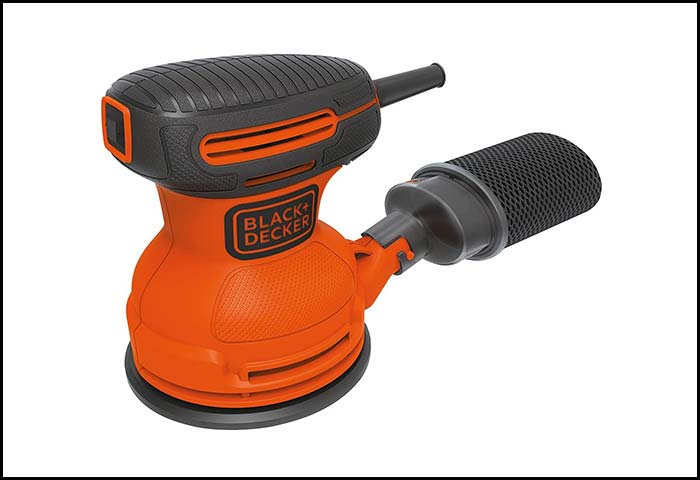
Why This Product Is Our Pick
The title for this category says it all. This inexpensive orbital sander will set you back less than 30 bucks! I have never seen and orbital sander with a lower price point. The compact design actually gives you a couple of ways to hold the machine – either by the rubberized top grip area, or by simply wrapping your hand around the entire body of the thing. Don’t expect high performance from this bargain sander, but if you’re looking for a light-duty machine, you just found it.
Detailed Review
At just 7x5x6 inches and only 3 pounds, this diminutive sander is tiny enough to fit anyplace you might need a sander to go. The key point here, though, is that it is a smallish machine. It has only a 2-amp motor driving the 5-inch sanding plate. So, don’t expect to tackle big jobs that require a lot of material removal. This is a great sander for finishing small projects.
The switch is sealed against dust. Good thing, because online reviews by owners suggest the dust collection system isn’t very effective. It also isn’t designed to be easily connected to a vacuum hose. It does use the standard 5-inch hook and loop backed sanding discs that can be bought at any hardware or home improvement store. It does not have variable speed settings.
Online reviews from purchasers of the Black & Decker BDERO100 give it a ranking of 8.6 out of 10. There are a few too many complaints about a short lifespan of the machine for my comfort. This Black & Decker orbital sander does come with a limited 2-year warranty, which is a good thing because you might need it.
Then again, I suspect that many who complained of the machine burning itself out may have been asking more from it than this orbital sander was designed to do. Just understand that this sander is designed for small jobs, and you’ll get along just fine.
Pros
- Crazy low price
- Small and maneuverable in tight spots
Cons
- Underpowered 2-amp motor
- No variable speed settings
- Reports of motor and switch burnouts
Final Verdict
I would not choose this model as the primary candidate for my wood working shop. However, if I was a hobbyist who enjoyed occasionally refinishing old furniture, for example, I might very well reach for this little guy. For about the same price as a couple of “value” meals at your local fast food outlet, there’s no denying this orbital sander from Black & Decker is a bargain.
04 Makita XOB01Z 18V LXT
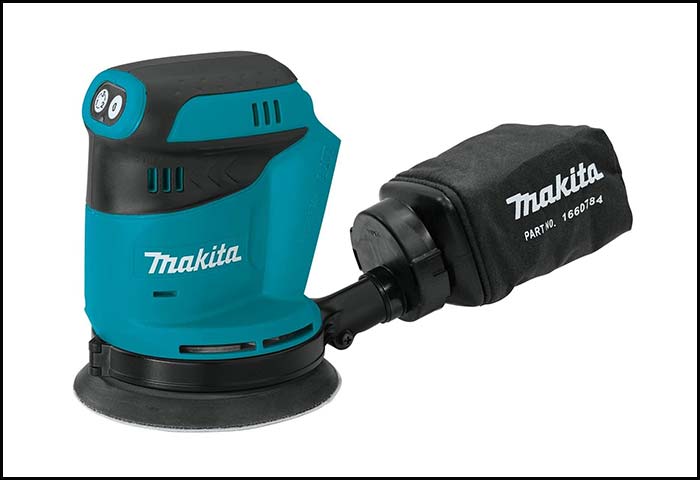
Why This Product Is Our Pick
The most annoying thing about using an orbital sander on a large project such as a tabletop, is how the cord always manages to get caught on something as you try to make large, smooth passes with the sander. Makita does away with that annoyance by relying on lithium-ion battery power in this sophisticated random orbital sander.
Toss in a few features like 3 speed settings; a rubbery, ergonomically pleasing grip area; and a satisfactory (not great) dust collector bag, and you’ve got an orbital sander that you can take anywhere.
Detailed Review
The main difference between this highly rated orbital sander and any of the others in our review is that it is cordless. So, let’s talk about that first. I have a tendency to stay away from cordless power tools. The word “power” seems like a misnomer because, well, most of them aren’t powerful and battery life is disappointing. But in the case of this random orbital sander, I have to eat my words. This machine is fully capable of running for 40 solid minutes (on the low speed setting) on a single battery. That’s not so bad. However, on high speed, that battery life is cut in half (which isn’t so good).
Speaking of speeds, this machine has 3 speed settings – 7,000 OPM, 9,500 OPM, and 11,000 OPM. The on/off button resides just under your index finger at the front of the handgrip and the switch that changes the power setting is right next to it, making the dust-sealed switches ideally placed.
Another peeve is the cost of battery-powered tools. Sure, this orbital sander will only set you back about one-hundred bucks. But a pair of batteries for it are an additional $220 and the charge is another $38. So, to get this system up and running is going to cost more than $350!
Now, if you want to outfit your shop with a lot of Makita cordless tools that use the same battery, you may be able to justify this investment. Going cordless certainly is a very handy option, but it isn’t cheap.
Pros
- Cordless versatility
- Relatively good battery life
- Handy 3-speed switch
Cons
- Expensive battery options
- Short battery life on high speed
Final Verdict
Dragging a cord across a surface that I am trying to finish to smooth perfection is certainly annoying, enough so to make me think very seriously about going cordless. My complaint about this machine (or any cordless power tool) is the significant investment I have to make in batteries. It forces me to buy more cordless tools from the same manufacturer. That’s a trap that I don’t like getting back in to.
However, if I were going to take the cordless bait (and working at remote sites is a great reason why I would), this is the option I would go for.
05 Bosch 6.5-Amp Random Orbital Sander
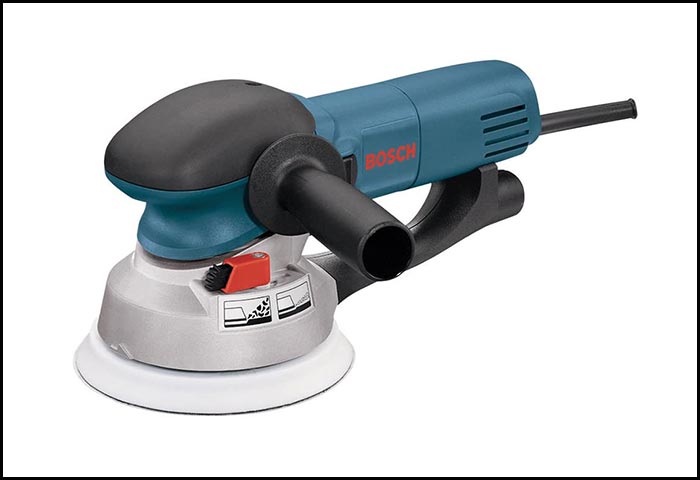
Why This Product Is Our Pick
The reason this is our Advanced Choice is that it has every feature you could possibly want from a sander, and enough power to push through any task you assign it. In fact, it has so much power that it actually features two sanding modes. The random orbit mode is the same as every other sander in our reviews. But this machine adds a “turbo” driven eccentric orbit setting that Bosch says removes material 5 times fast than the standard setting.
It is also packed with many top-end features including a speed dial and soft start-up and shut-down features that prevent surface damage during these transitions.
Detailed Review
A 6.5-amp motor drives this dual-mode sander. That’s reason enough to buy it. But let’s talk about the dual mode thing. In the standard mode, it acts just like any other random orbital sander. But in “turbo” mode, it takes on the movements of an eccentric orbit sander which grinds away material exponentially faster. So, you can get the rough work done very quickly, then flip the switch to standard random orbit mode and finish the job with ease.
That motor is controlled by circuitry that works to keep the sanding pad at a constant speed, wherever you have set it on the variable scale, by adjusting the power of the motor to meet the demand regardless of the load you are putting on it. Pretty cool.
Let me also point out that this sander uses a 6-inch disc, whereas every other sander in our survey uses a 5-inch disc. That may not sound like much, but do the math. A 5-inch disc has 19.635 square inches of surface area, and a 6-inch disc has 28.274 square inches. That more than 30% larger! Think about how much faster you can get the job done.
The sanding pads that fit this Bosch sander have a soft backing to them, which Bosch says allows them to conform to the surface you are sanding better, to give you a smoother finished product. The rubberized top shell and detachable side handle (also with a rubber inset) make working with this machine very comfortable.
One beef. It doesn’t come with a dust bag or canister. It is designed to attach to a Bosch vacuum, which is a necessary thing to do.
Pros
- Dual-mode option
- Extreme power
- 6-inch sanding disc
Cons
- No dust bag or cansiter
Final Verdict
Call it professional grade, call it heavy-duty, call it what you want. This is an orbital sander that can handle any job. A belt sander associated with this one can do wonders and the smooth finish will turn heads of every wood enthusiast. It is going to set you back about $270 at the cash register, but it’s also the last orbital sander you’ll ever have to buy. If you’re looking for a big gun when it comes to heavy duty sanding, this is your pick.
06 Bosch Random Orbit 5-inch Sander

Why This Product Is Our Pick
It’s like Bosch took a plaster casting of my hand, and then figured out how to design a sander that would fit my hand perfectly in about ten different positions. Seriously, the rubberized grip of this little member of our reviews is worth singing about (too bad I can’t sing).
The switch is right up front where my index finger can find it without even trying. The cushy grip area covers nearly the entire body of the sander. Here’s the catch; It doesn’t matter whether I’m right-handed or left-handed, the grips feel exactly the same either way. You may laugh at that, but the ten percent of the population who prefers to use the left hand finds many power tools unusable. Not this sander.
Detailed Review
Vibration transfer is nicely dampened through the soft grip area on this little Bosch. The 2.5-amp motor delivers its power through a variable speed control. The speed is adjustable from 7.500 OPM to 12,000 OPM. That’s a nice range. Electronic circuitry assures that the motor maintains a constant speed even under varying load conditions. All of that translates into a low-vibration orbital sander that can be used for extended periods of time without fatigue.
This ranks as a handy random orbital sander in my book because with a weight of only 3.5 pounds, an adjustable speed, light weight, and the ability to be gripped in a wide variety of ways, it simply eliminates the fatigue associated with extended sanding projects.
Dust is collected in a hard-cased container that includes a micro-filter for optimal collection. It can also be attached to a vacuum. The canister and filter is a nice combination, although the canister is fairly small and requires frequent emptying. That’s a small matter, though, because a larger container would simply get in the way.
Online reviewers who have purchased this little orbital sander have given it an 8.6 rating out of 10. But they have expressed concerns about the dust trap. It seems that the microfilter doesn’t hold up well over time, and replacement requires buying a whole new dust canister, not just the filter, to the tune of about $20.
But, again, this is our comfort pick and it certainly excels in that department. This is a random orbital sander you can use all day with ease.
Pros
- Comfortable for left- or right-handed use
- Low vibration
- Light weight
Cons
- Short lifespan for the microfilter
Final Verdict
For about $70, this is a very capable, and comfortable to operate, random orbital sander. It has a relatively low-power motor and no second hand grip, which are clear signals that this sander is designed for lighter duty applications. That’s fine. We need sanders like that, too, and this one fits the bill very nicely.
07 Tacklife 5-inch 6 Variable Speed Sander

Why This Product Is Our Pick
Tacklife is not exactly a household name in the world of power tools. But the nameplate on my tools never transfers to my finished wood working pieces, so I don’t really care. What I do care about is that this random orbital sander has a powerful motor, adjustable speeds, and orbits up to 13,000 times per minute. All of that tells me that it will get the job done.
Detailed Review
The 3-amp motor in this sander is up to the task at hand. There is no question about that. It also has a nicely-sized dust collection bin, although in my experience, it didn’t do the greatest job of snatching all of that dust. There was plenty left floating in the air.
The variable speed control has 6 presets, with the highest setting being 13,000 OPM. There is not an electronic control that maintains the speed regardless of applied pressure, so it is possible to bog this sander down with too much pressure. Not a big deal, but be aware of it.
What is a big deal to me is the build of the tool. This sander is designed to fill a low-cost, light usage niche. At around $43, it’s not quite the cheapest model on our list. But the seemingly lightweight quality of the plastic casing makes it feel like it should be. I’m also not sold on the two-paddle on/off switch. Seems like twice the opportunity for problems.
Although this sander won’t find a home in my wood working shop, it may certainly feel at home in many hobbyists and homeowners arsenals of basic tools. That’s where it belongs, and it is perfectly suited for that assignment.
Pros
- 6 speed presets
- Low price
Cons
- Cheap plastic feel
- Odd power switch
Final Verdict
Owners of the Tacklife model have given it an 8.2 out of 10 rating, indicating some concerns. The majority of complaints are about durability of the machine. Look, this is a compact machine designed for light usage. If you are trying to punish it with heavy-duty jobs, that’s operator error in my book. Choose the right tool for the job and you won’t have a problem. If you are a homeowner who occasionally has to sand a sticky door edge or refinish a plant table, this sander is a fine choice.
08 DeWalt DWE6423K

This is a 3-amp random orbit sander with speed settings adjustable from 8,000 OPM up to 12,000. Like all DeWalt models, it has a counterweight that balances the actions of the sanding pate to dampen vibration and make it a lot more comfortable for the operator. The grip areas are also rubberized for even more comfort. I certainly appreciate that.
It has DeWalt’s standard high-quality feel to everything about the machine. That’s why it also has a 3-year warranty. A dust-sealed switch and stubby profile mean it is handy, durable, and stands up to any other random orbital sander on the market.
Online reviews from owners of this sander give it a 9.2 rating, with 81% giving it a straight 10. That’s a pretty solid endorsement of a sanding tool that sells for only about $90. Heck, I’ve even seen it on sale for under $70. That’s a steal.
Pros
- Quality construction
- Low Vibration
Cons
- Sone reviewers report problems with the switch
- No option for a second handle
Final Verdict
I like this sander form DeWalt. A lot. There’s really no major problem with it. The thing is, there are other sanders in our search for top models that I like better, including other DeWalt models. So, while there’s no reason not to buy this machine, there’s really no reason to buy it. If this one trips your trigger, get it. It’s a perfectly fine choice.
09 Bosch ROS65VC-5
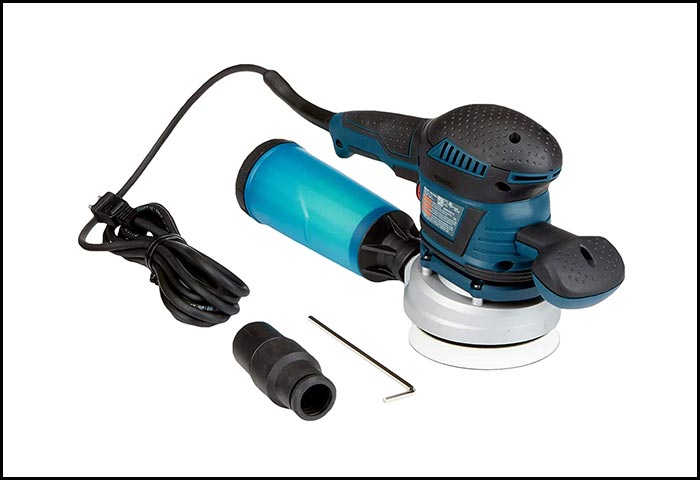
This machine from Bosch is a true workhorse. It’s not the biggest. It’s not the baddest. It’s not even the best. But it’s a darn good machine, and having it in your shop is nothing to be ashamed of. In fact, it’s good enough to make any woodworker proud. The two-handle design makes this a comfortable and easy to control machine that will yield great results. Bosch employs a suspension system on the pad that helps dampen vibration. That, combined with the two soft grips, make this a machine you can easily use all day long.
It has a 3.3-amp motor and variable speed dial, so you can tune it to the exact needs of your job. It employs that soft-backed sanding disc design that Bosch uses on many of its sanders, which provides a unique feel and great results.
It has a decent sized dust canister equipped with a microfilter that seems to do a very good job of containing the remnants of your sanding task. And it’s one of the few machines on the market that actually comes with the adapters necessary to attach it to a vacuum!
At about $193, this is a fairly pricey entry in the field of random orbital sanders. That’s one of the main reasons it doesn’t rank higher in our results. Reviews from owners give this random orbital sander an 8.8 rating, with more than 80% casting a full-on 10 vote.
Pros
- Two handle design
- Vibration dampening design
- Powerful motor
- Vacuum adapters included
Cons
- High price
Final Verdict
If you can look past the fairly high price of this machine, this is a great choice to own. It is a case of you get what you pay for, because there is really nothing wrong with this sander. Only the price point prevented it from ranking higher top list. But, since this sander will outlast a low-priced random orbital sander by a factor of 4 or more, it really isn’t that great a price to pay. Just get it.
10 Makita BO5030K
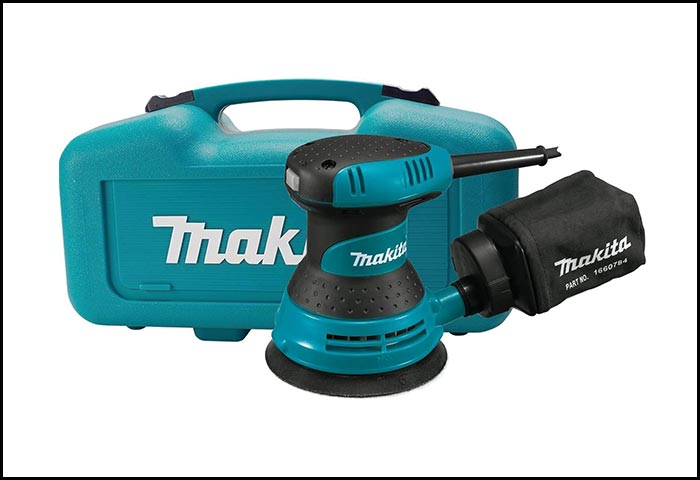
I love a random orbit sander that I can grip from the top, the side, the left side, the right side, front, back, or just about any other way I can think of. It helps reduce hand fatigue. This sander from Makita is exactly that kind of design. It is essentially cylindrical, and rubberized all the way around, so the way you choose to hold it is entirely up to you.
This machine, like many others in our review, has a pad control system that eases the pads into and out of motion to help reduce or eliminate those pesky swirly marks on your wood surfaces. One of the things it doesn’t have is a variable speed control. The 3-amp motor churns out 12,000 orbits per minute.
The Makita name is well-known and respected among power tool aficionados, and Makita backs this reputation with a on-year warranty for this machine. At only about 60 bucks, I would consider this an entry level offering from Makita. But, their entry level is substantially higher than many top-of-the-line offerings from lesser companies.
This machine doesn’t have many bells and whistles. There is no speed adjustment, no second handle, no fancy this-and-that. This is just a very good, very usable, basic random orbit sander from a great tool company.
Pros
- Quality brand
- Multiple grip options
Cons
- Single speed
Final Verdict
This is a very basic sander from a very reputable manufacturer. That means if you want a quality tool without having to pay a lot of money, this is the choice for you. It is a good enough machine for almost any application, and the quality of construction built into it means you may never have to replace it. That’s a very good deal in my book. Status symbol? No. Great random orbit sander? Yes.
Random Orbital Sander Buying Guide
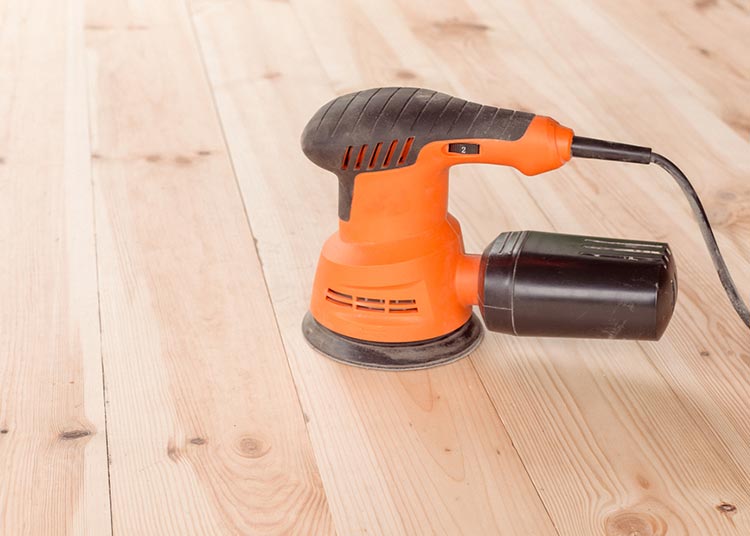
Top Factors to Look For
My main concern with a random orbit sander is user comfort. Sanding can be a tedious task, and if the machine you are using is hard to hold or vibrates too much, you are going to get fatigued. This leads to a less-than-satisfactory result and even to mistakes or injury. So, the first think I look for is whether the machine has a comfortable gripping area. Is it rubberized? Can I hold it in different ways to reduce fatigue? Can I hold it with either hand? Are the grip positions adjustable or fixed?
Next, I look for power. An underpowered sander can bog down, resulting in a poor workflow and even damage to the surface you are sanding. Excess power never causes a problem, but insufficient power always leads to poor results.
Then I look to added features, like variable speed, dust collection systems, base plate design, and warranty terms.
Variable speed on a random orbit sander isn’t actually as big a deal as it might seem. Yes, it’s nice to have. But I find myself using the highest speed setting almost all of the time anyway. These machines simply do a better job the faster they are orbiting. There is one very notable exception to this point. If I am sanding the edges of a piece of clear plastic, I will choose the slowest speed possible on my sander. Run your sander too fast, and the heat build-up caused by the sanding motion can actually cause the plastic to melt rather than be abraded away by the sanding medium.
Dust collectors are vital on sanders. The microscopic dust generated is annoying, gets everywhere, and isn’t something you want to breathe. Hooking up to a vac is always a good idea, but not always practical. So the random orbit sander should have a reasonably good dust collection system built into its design.
Pitfalls to Avoid
Nothing is more irritating than a random orbital sander that vibrates so badly it makes my hand go numb. An ideal random orbital sander will have a soft grip area (and preferably more than one way to hold it) and a counterweighted system that absorbs the vibration generated by the elliptical behavior of the pad. You can tell in two seconds whether a machine vibrates too much. Pick it up and turn it on. If it immediately feels like it’s dancing in your hand, put it down and walk away.
An underpowered motor is also a concern for two reasons. First, it will lead to a poor quality result because the machine will bog down and fail to orbit at a high enough speed. Secondly, since you’ll be fighting with it to get the task finished, the motor will probably burn out prematurely.
What Is a Random Orbit Sander
These machines are among the most versatile power sanders on the market. Because they move the sanding pad in an elliptical fashion, they can take down many layers of paint on old pieces of wood in no time at all. Or, they can give a piece of finished work an extraordinarily smooth finish without leaving any telltale sanding marks or streaks.
Why Use Random Orbit Sanders

You’ll get smoother surfaces with an orbit sander if you know how to sand properly. For both the roughest and finest forms of sanding tasks, random orbital sanders simply perform better than most other machines. They are also hands-down better at the job than hand sanding, in most applications.
Many of these sanders are also not large machines (a 5-inch sanding pad is the de facto standard for most of them) so they are easy to use. Getting great results from these machines isn’t that hard.
How Random Orbit Sanders Are Different from Other Types of Sanders
The difference is in the motion the machine uses to sand a surface. It spins in an elliptical manner, so as you move the machine across the surface, every point on the surface actually gets sanded from a different angle up to 14,000 times per minute (depending upon the speeds of your machine).
A palm sander is ideal for sanding on 90-degree corners. A sheet sander only moves back and forth. An orbit sander only spins on a single axis. A good sander drags the sanding medium across the surface in one direction. Each of these does a good job for certain applications, but they are prone to leaving streaks across your surface that mirror the design of the sanding motion. Because the random orbital sander attacks from so many angles, it is a virtually streak-free sanding method.
How to Use a Random Orbit Sander?
This is a simple machine easy to use. Sanding discs attach to the base plate by a simple hook-and-loop system. When sanding, you don’t have to bear down on these machines too much. Rough sanding jobs, like stripping old finishes, do require putting a little weight into it. But when doing the finishing passes with a fine grit disc, the weight of the machine itself should be enough to do the job. Simply guide the machine in the right direction, and let it do the work.
Keep an eye on the sanding disc to know when it’s time to change it out for a new one. Here’s a basic rule of thumb. If you feel like the sander isn’t accomplishing as much as it was a minute ago, your disc is probably due for replacement. Don’t fight it.
Keep the dust collector clean. This is a vital part to making the sanding job enjoyable. Nobody wants to stand in a dusty environment. Empty the bag and clean the filter regularly, at least every time you change the pad.
Random Orbit Sander Safety Tips
Random orbital sanders are relatively safe machines to use. The only real danger is abrading your skin by coming in contact with the sanding disc. Keep your fingers away from the disc area, and you should be fine.
Always wear eye protection and a dust mask. The fine dust generated by sanding can be a nasty irritant in the eyes, and it is certainly not something you want in your lungs.
Random Orbit Sander Maintenance Tips
Modern random orbital sanders are virtually maintenance free. Simply clean all of the dust off the machine every time you are finished. Empty the dust collector and clean the filter if it has one. That’s about it!
It’s Time to Wrap Up
I have five sanding machines in my shop, and they all have a purpose. But the one I reach for most often is my random orbital sander. It is the most versatile, easiest to use, and just does a great job. I have a small confession to make. I love woodworking, but the sanding part bores me to death. However, when I’m using the random orbital, seeing a rough surface turned into a glassy-smooth one so quickly and without sanding streaks makes me so happy that I actually forget that I’m sanding.
There’s no denying that this machine is indispensable for any woodworker. I hope that my reviews have helped you decide which is going to be the best random orbit sander for your needs. Pick one up today, and you’ll be glad you did!






